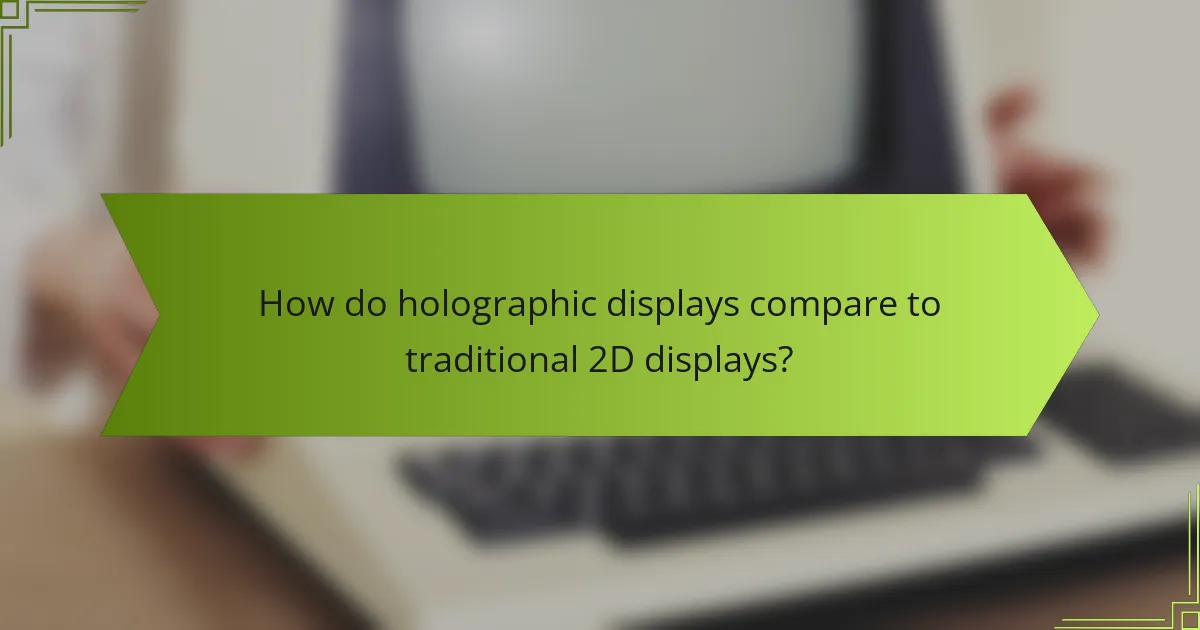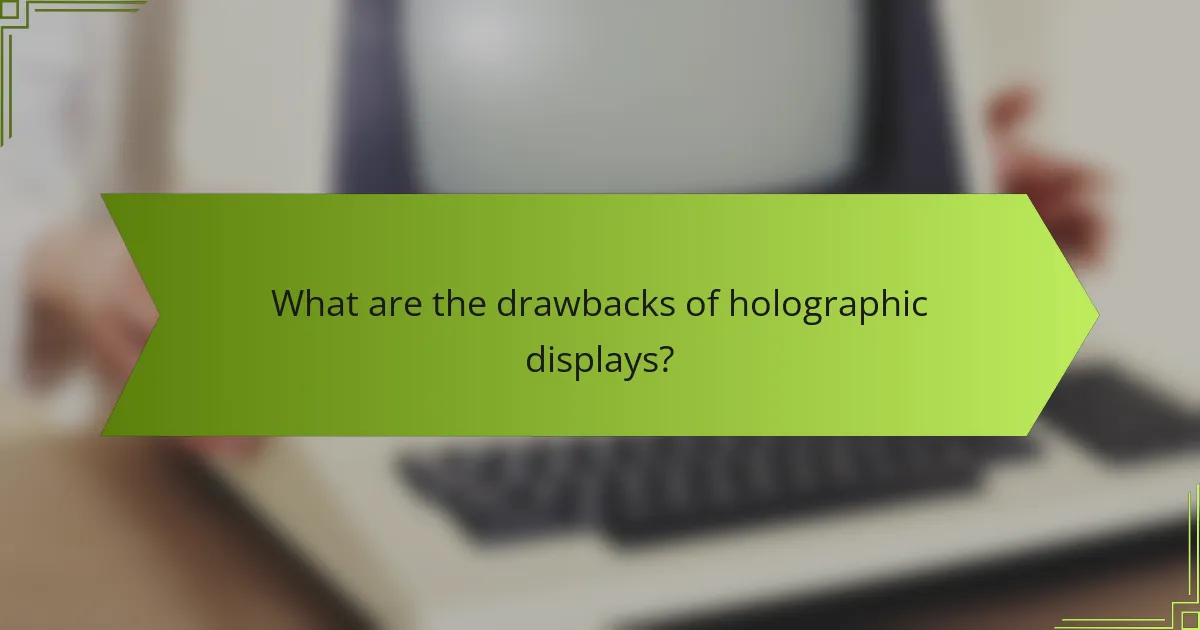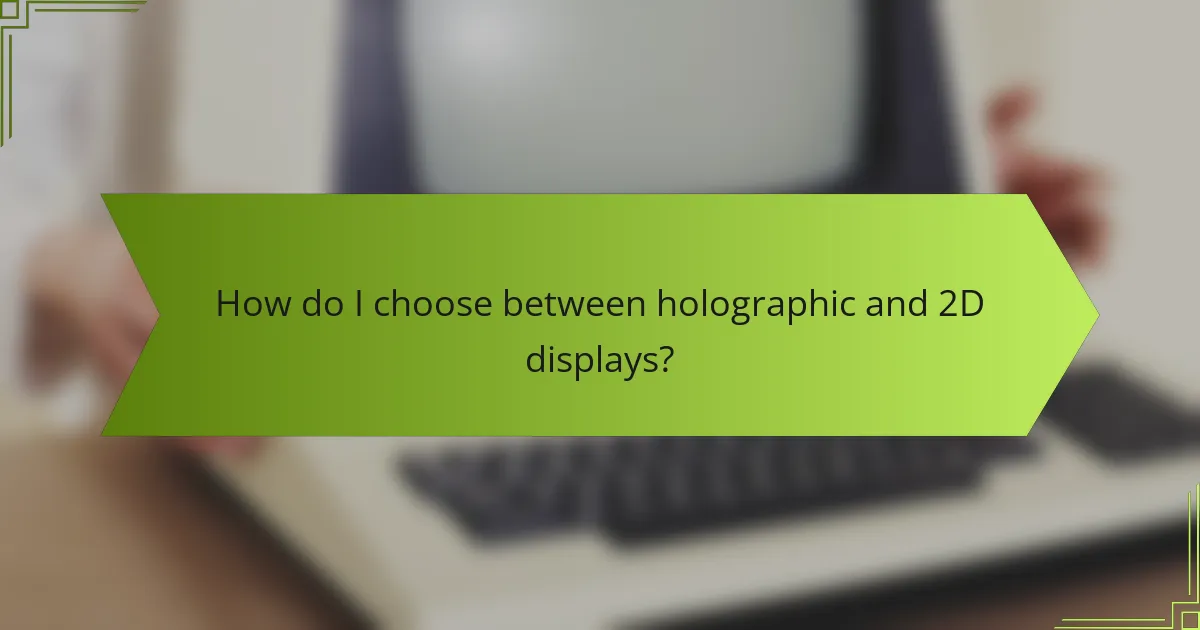Holographic displays provide a unique three-dimensional visual experience that sets them apart from traditional 2D displays, which only offer flat images. This distinction enhances depth perception and user engagement, making holographic technology increasingly attractive for diverse applications such as entertainment and education. However, challenges such as energy consumption and limited viewing angles must be considered when comparing these innovative displays to their conventional counterparts.

How do holographic displays compare to traditional 2D displays?
Holographic displays offer a three-dimensional visual experience, unlike traditional 2D displays that present flat images. This difference significantly impacts depth perception, user engagement, and production costs, while also presenting challenges in content availability.
Enhanced depth perception
Holographic displays provide enhanced depth perception by allowing viewers to see images in three dimensions, creating a more realistic representation of objects. This technology uses light interference and diffraction to project images that appear to float in space, which can be particularly beneficial in fields like medicine and design.
In contrast, traditional 2D displays only offer a flat representation, limiting the viewer’s ability to gauge depth and spatial relationships. For instance, in architectural visualization, holographic displays can help clients better understand the scale and layout of a project compared to a standard screen.
Improved user engagement
User engagement tends to be higher with holographic displays due to their immersive nature. The ability to interact with 3D images can captivate audiences, making it an effective tool for marketing, education, and entertainment.
For example, museums using holographic exhibits can draw in visitors who are eager to explore interactive displays, compared to static 2D images. This increased engagement can lead to longer viewing times and a more memorable experience.
Higher production costs
The production costs for holographic displays are generally higher than those for traditional 2D displays. This is due to the advanced technology and materials required to create and project holograms, which can be significantly more expensive.
Investing in holographic technology may not be feasible for all businesses, especially smaller ones. Companies should weigh the potential benefits against the costs, considering whether the enhanced experience justifies the investment.
Limited content availability
Currently, there is limited content available for holographic displays compared to traditional 2D formats. While 2D content is abundant and easily accessible, creating holographic content requires specialized skills and tools, which can hinder widespread adoption.
As the technology matures, the availability of holographic content is expected to grow, but businesses should be aware of this limitation when considering the transition. Developing a strategy for content creation or partnering with specialized providers may be necessary to fully leverage holographic displays.

What are the benefits of holographic displays?
Holographic displays offer several advantages over traditional 2D displays, including enhanced visual experiences, interactivity, and compact designs. These benefits make them increasingly appealing for applications in various fields such as entertainment, education, and advertising.
Immersive visual experience
Holographic displays create a three-dimensional visual experience that engages viewers more deeply than standard 2D screens. This immersive quality allows users to perceive depth and perspective, making content feel more realistic and engaging.
For instance, in gaming or virtual reality applications, holographic visuals can enhance the sense of presence, leading to a more captivating experience. Users often report feeling as if they are part of the environment rather than just observing it.
Interactive capabilities
Holographic displays enable users to interact with content in real time, allowing for a more dynamic experience. This interactivity can include gestures, touch, and even voice commands, making it possible to manipulate 3D objects directly.
For example, in educational settings, students can explore complex subjects like anatomy or physics by interacting with holograms, leading to improved understanding and retention. This hands-on approach fosters engagement and encourages active learning.
Space-saving design
Holographic displays often have a more compact footprint compared to traditional monitors, making them suitable for environments with limited space. Their ability to project images into the air means they can eliminate the need for bulky screens and furniture.
This space-saving feature is particularly beneficial in retail and exhibition settings, where maximizing floor space is crucial. Holographic displays can be integrated into various environments without overwhelming the available area, providing a modern and sleek aesthetic.

What are the drawbacks of holographic displays?
Holographic displays have several drawbacks compared to traditional 2D displays, primarily related to energy consumption and viewing angles. These limitations can affect their practicality and user experience in various applications.
Higher energy consumption
Holographic displays typically consume more energy than standard 2D displays due to the complex technology involved in creating three-dimensional images. This increased energy usage can lead to higher operational costs, especially in settings where multiple displays are used, such as in retail or advertising.
For example, while a conventional LED screen may use around 50-100 watts, a holographic display could require significantly more, potentially doubling or tripling that figure. Users should consider the long-term energy costs when deciding on holographic technology.
Viewing angle limitations
Holographic displays often have restricted viewing angles, which can limit the effectiveness of the display in certain environments. Unlike traditional displays that can be viewed clearly from various angles, holographic images may only be visible from specific positions, diminishing their impact.
This limitation can be particularly problematic in public spaces or large rooms where multiple viewers may be present. Users should evaluate the intended usage scenario to ensure that the viewing angle meets their needs, as this can affect audience engagement and overall satisfaction.

What industries benefit from holographic displays?
Holographic displays are transforming various industries by providing immersive visual experiences that enhance interaction and understanding. Key sectors include healthcare, entertainment, and education, where these displays facilitate better communication and engagement.
Healthcare applications
In healthcare, holographic displays are used for surgical planning and visualization of complex anatomical structures. Surgeons can view 3D holograms of patient data, improving precision during procedures and reducing risks.
Additionally, holography aids in patient education by allowing individuals to visualize their conditions and treatment options in a more interactive manner. This can lead to better patient understanding and compliance with medical advice.
Entertainment and gaming
The entertainment industry leverages holographic displays to create immersive experiences in movies and live performances. Holograms can bring characters to life on stage, providing audiences with a unique visual spectacle that traditional 2D displays cannot match.
In gaming, holographic technology enhances gameplay by allowing players to interact with 3D environments. This level of engagement can significantly increase the enjoyment and realism of gaming experiences.
Education and training
Holographic displays are revolutionizing education by enabling interactive learning experiences. Students can explore complex subjects, such as biology or physics, through 3D visualizations that make abstract concepts more tangible.
In training scenarios, such as for pilots or medical professionals, holograms can simulate real-world situations, allowing learners to practice skills in a safe environment. This hands-on approach can improve retention and application of knowledge.

How do I choose between holographic and 2D displays?
Choosing between holographic and 2D displays depends on your specific needs, including the intended application, budget, and desired audience interaction. Holographic displays offer a unique visual experience but may come with higher costs and technical requirements compared to traditional 2D displays.
Assessing use case requirements
Start by identifying the primary purpose of the display. Holographic displays are ideal for applications requiring immersive experiences, such as medical imaging, design visualization, or interactive advertising. In contrast, 2D displays are suitable for standard presentations, video playback, and general information sharing.
Consider the environment where the display will be used. Holographic displays often require controlled lighting conditions and specific viewing angles, while 2D displays can function effectively in a wider range of settings.
Evaluating budget constraints
Budget is a critical factor in your decision. Holographic displays typically come at a premium, often ranging from several thousand to tens of thousands of dollars, depending on the technology and size. In contrast, 2D displays are generally more affordable, with options available from a few hundred to a few thousand dollars.
Factor in not just the initial purchase cost but also ongoing maintenance and potential software requirements for holographic systems, which can add to the total expenditure.
Considering audience engagement
Evaluate how you want your audience to interact with the display. Holographic displays can significantly enhance engagement through interactive elements, making them suitable for exhibitions, trade shows, or educational settings. They can captivate viewers and encourage participation.
On the other hand, 2D displays may suffice for straightforward content delivery where interaction is minimal. Assess your audience’s preferences and the level of engagement you aim to achieve to make an informed choice.

What are the future trends in holographic display technology?
The future of holographic display technology is set to revolutionize visual experiences through enhanced realism and interactivity. Key trends include advancements in display resolution, integration with augmented reality, and the development of broader content creation tools.
Advancements in display resolution
Future holographic displays are expected to achieve significantly higher resolutions, improving clarity and detail. Current technologies are moving towards resolutions that can exceed 4K, with some projections suggesting capabilities in the range of 8K and beyond.
Higher resolution displays will allow for more lifelike images and smoother visuals, making them suitable for applications in entertainment, education, and professional fields. This improvement will also reduce the pixelation effect seen in lower-resolution displays, enhancing the overall viewing experience.
Integration with augmented reality
Holographic displays are increasingly being integrated with augmented reality (AR) technologies, allowing users to interact with digital content in real-world environments. This integration enhances user engagement by overlaying holographic images onto physical spaces, creating immersive experiences.
For instance, in retail, customers could visualize products in their homes before purchasing, while in education, students might interact with 3D models of historical artifacts or scientific phenomena. This trend is expected to grow as AR applications become more mainstream and accessible.
Broader content creation tools
The development of user-friendly content creation tools for holographic displays is on the rise, enabling more creators to produce holographic content without extensive technical knowledge. These tools are designed to simplify the process of creating 3D models and animations that can be displayed holographically.
As these tools become more widespread, expect an increase in diverse content ranging from entertainment to educational materials. This democratization of content creation will likely lead to a richer library of holographic experiences, catering to various industries and audiences.
